Machine Learning in Slope Stability: A Review with Implications for Landslide Hazard Assessment
Abstract
1. Introduction
2. Factors Affecting Slope Stability
2.1. Slope Geometry
2.2. Geological Structures
2.3. Groundwater and Hydrogeology
2.4. Lithology
2.5. Cohesion and Friction Angle
2.6. Blasting and Mining Activities
3. Traditional Deterministic Methods for Slope Stability Analysis
3.1. Limit Equilibrium Method (LEM)
3.1.1. Bishop’s Simplified Method
3.1.2. Janbu’s Method
3.1.3. Spencer Method
3.2. Finite Element Methods (FEM)
- 1.
- Equilibrium Equations (force balance)
- 2.
- Constitutive Equations (stress–strain relationships)
- 3.
- Compatibility Equations (deformation continuity)
- 4.
- Finite Element Formulation
- 5.
- Shear Strength Reduction (SSR) Method
3.3. Analytical Methods
3.4. Challenges of Deterministic Methods
4. Stochastic Methods for Slope Stability Analysis
4.1. Stochastic Finite Element Method (SFEM)
4.2. Stochastic Response Surface Method (SRSM)
4.3. Stochastic Simulation with Transition Probabilities and Markov Chains
4.4. Jointly Distributed Random Variables (JDRV) Method
4.5. Stochastic Kinematic Analysis
4.6. Challenges of Stochastic Methods
5. Machine Learning Methods
5.1. Supervised Learning
5.1.1. Decision Trees (DT)
5.1.2. Random Forest (RF)
5.1.3. Support Vector Machine (SVM)
5.1.4. Gradient Boosting Machine (GBM)/XGBoost
5.1.5. Artificial Neural Networks (ANNs)
5.1.6. Key Advantages of Supervised Learning
- High Prediction Accuracy: The supervised learning algorithms random forest (RF), support vector machine (SVM), and extreme gradient boosting (XGBoost) demonstrate exceptional accuracy when predicting slope stability results.
- Interpretability: Through supervised algorithms stakeholders can understand which input variables most affect slope stability because these algorithms reveal their relative importance.
- Handling Complex Data: Advanced modeling systems have the capacity to evaluate numerous determinants like slope angle while also considering vegetation cover and structural conditions. The system allows comprehensive stability analysis while enabling detailed studies of slope behavior.
- Improved Computational Efficiency: Supervised learning models within Machine Learning frameworks function as surrogate models that enhance computational efficiency when analyzing stochastic slope stability. The resulting effect is a reduction in costs traditionally incurred by deterministic methods.
- Robustness and Reliability: Ensemble-based supervised learning frameworks such as RF and XGBoost demonstrate significant robustness for classification tasks by providing reliable predictions across multiple datasets and environmental conditions.
- Feature Importance Analysis: Supervised learning approaches can be adjusted and refined for different datasets and environmental conditions which makes them effective tools for slope stability analysis in multiple geographic and ecological areas.
5.2. Unsupervised Learning
5.2.1. K-Means Clustering
5.2.2. Gaussian Mixture Models (GMM)
5.2.3. DBSCAN (Density-Based Clustering)
5.2.4. Key Advantages of Unsupervised Learning
- Data Handling and Preprocessing: Efficient management and preprocessing of large datasets by unsupervised learning is an important component in slope stability analysis due to the need to integrate and standardize data collected from various sources, such as laboratory test results, geotechnical measurement equipment, and radars [9].
- Pattern Recognition: By identifying data patterns and anomalies, it enables detection of potential slope failure by analyzing geotechnical and environmental factors without the need for prior data labeling [56].
- Dimensionality Reduction: The use of clustering and principal component analysis (PCA) reduces data complexity which improves both the visualization and interpretation of slope stability variables [9].
- Anomaly Detection: Outlier identification and unusual pattern recognition in slope data through unsupervised methods provide indicators of potential instability and failure risks [56].
- Adaptability: Unsupervised learning adjusts to new conditions and data inputs, making it ideal for dynamic slope monitoring and analysis applications [57].
- Or, in terms of a confusion matrix:
- Precision: Focuses on the accuracy of positive predictions. It is crucial when false positives are costly (e.g., spam detection).
- Recall: Measures the model’s ability to find all actual positive instances. It is crucial when false negatives are critical (e.g., medical diagnosis).
- F1-score: The harmonic mean of precision and recall, providing a balanced measure.
- AUC-ROC: Summarizes the model’s performance across different classification thresholds.
5.2.5. Comparative Analysis of Supervised and Unsupervised Learning
6. Analysis and Discussion
6.1. Most Effective Machine Learning Techniques to Estimate the Factor of Safety
6.1.1. Multilayer Perceptron (MLP)
6.1.2. Support Vector Regression (SVR)
6.1.3. Stochastic M5P Model
6.2. Most Effective Machine Learning Techniques for Classifying a Slope as Stable or Unstable
- Extreme Gradient Boosting (XGBoost)
- Random Forest (RF)
- Support Vector Machines (SVM)
6.2.1. Extreme Gradient Boosting (XGBoost)
6.2.2. Random Forest (RF)
6.2.3. Support Vector Machine (SVM)
6.3. Analysis of the Results
7. Conclusions
Author Contributions
Funding
Data Availability Statement
Acknowledgments
Conflicts of Interest
References
- Kolapo, P.; Oniyide, G.O.; Said, K.O.; Lawal, A.I.; Onifade, M.; Munemo, P. An Overview of Slope Failure in Mining Operations. Mining 2022, 2, 350–384. [Google Scholar] [CrossRef]
- Chandarana, U.; Momayez, M. Monitoring and predicting slope instability: A review of current practices from a mining perspective. Int. J. Res. Eng. Technol. 2016, 5, 139–151. [Google Scholar] [CrossRef]
- Xu, H.; He, X.; Shan, F.; Niu, G.; Sheng, D. Machine Learning in the Stochastic Analysis of Slope Stability: A State-of-the-Art Review. Modelling 2023, 4, 426–453. [Google Scholar] [CrossRef]
- Ahangari Nanehkaran, Y.; Pusatli, T.; Chengyong, J.; Chen, J.; Cemiloglu, A.; Azarafza, M.; Derakhshani, R. Application of Machine Learning Techniques for the Estimation of the Safety Factor in Slope Stability Analysis. Water 2022, 14, 3743. [Google Scholar] [CrossRef]
- Fisher, B.R.; Eberhardt, E. Assessment of Parameter Uncertainty Associated with Dip Slope Stability Analyses as a Means to Improve Site Investigations. J. Geotech. Geoenviron. Eng. 2012, 138, 166–173. [Google Scholar] [CrossRef][Green Version]
- Rusydy, I.; Canbulat, I.; Zhang, C.; Wei, C.; McQuillan, A. The Development and Implementation of Design Flowchart for Probabilistic Rock Slope Stability Assessments: A Review. Geoenviron. Disasters 2024, 11, 28. [Google Scholar] [CrossRef]
- He, Y.; Li, Q.; Zhang, N.; Li, C. Slope Reliability Analysis Based on PSO-RBF Neural Network. J. Phys. Conf. Ser. 2019, 1325, 12074. [Google Scholar] [CrossRef]
- Husein Malkawi, A.I.; Hassan, W.F.; Abdulla, F.A. Uncertainty and Reliability Analysis Applied to Slope Stability. Struct. Saf. 2000, 22, 161–187. [Google Scholar] [CrossRef]
- Lin, S.; Zheng, H.; Han, C.; Han, B.; Li, W. Evaluation and Prediction of Slope Stability Using Machine Learning Approaches. Front. Struct. Civ. Eng. 2021, 15, 821–833. [Google Scholar] [CrossRef]
- Kwon, S.; Pan, L.; Kim, Y.; Lee, S.I.; Kweon, H.; Lee, K.; Yeom, K.; Seo, J.I. Empirical Comparison of Supervised Learning Methods for Assessing the Stability of Slopes Adjacent to Military Operation Roads. Forests 2023, 14, 1237. [Google Scholar] [CrossRef]
- Ragam, P.; Kushal Kumar, N.; Ajith, J.E.; Karthik, G.; Himanshu, V.K.; Sree Machupalli, D.; Ramesh Murlidhar, B. Estimation of Slope Stability Using Ensemble-Based Hybrid Machine Learning Approaches. Front. Mater. 2024, 11, 1330609. [Google Scholar] [CrossRef]
- Nanehkaran, Y.A.; Licai, Z.; Chengyong, J.; Chen, J.; Anwar, S.; Azarafza, M.; Derakhshani, R. Comparative Analysis for Slope Stability by Using Machine Learning Methods. Appl. Sci. 2023, 13, 1555. [Google Scholar] [CrossRef]
- Zhou, X.; Xu, H.; Lin, G. Long-Term Time Series-Based Prediction of Mine Slope Displacement. In Proceedings of the 2023 16th International Conference on Advanced Computer Theory and Engineering (ICACTE), Hefei, China, 15 September 2023; IEEE: New York, NY, USA, 2023; pp. 1–6. [Google Scholar]
- Chaulagain, S.; Choi, J.; Kim, Y.; Yeon, J.; Kim, Y.; Ji, B. A Comparative Analysis of Slope Failure Prediction Using a Statistical and Machine Learning Approach on Displacement Data: Introducing a Tailored Performance Metric. Buildings 2023, 13, 2691. [Google Scholar] [CrossRef]
- Intrieri, E.; Carlà, T.; Gigli, G. Forecasting the Time of Failure of Landslides at Slope-Scale: A Literature Review. Earth-Sci. Rev. 2019, 193, 333–349. [Google Scholar] [CrossRef]
- Marcher, T.; Erharter, G.H.; Winkler, M. Machine Learning in tunnelling—Capabilities and challenges. Geomech. Tunn. 2020, 13, 191–198. [Google Scholar] [CrossRef]
- Li, X.; Zhang, L.; Xiao, T.; Zhang, S.; Chen, C. Learning Failure Modes of Soil Slopes Using Monitoring Data. Probabilistic Eng. Mech. 2019, 56, 50–57. [Google Scholar] [CrossRef]
- Mahmoodzadeh, A.; Mohammadi, M.; Farid Hama Ali, H.; Hashim Ibrahim, H.; Nariman Abdulhamid, S.; Nejati, H.R. Prediction of Safety Factors for Slope Stability: Comparison of Machine Learning Techniques. Nat. Hazards 2022, 111, 1771–1799. [Google Scholar] [CrossRef]
- Kalililo, M.; Xia, Y. UDEC-Based Stability Analysis of Jointed Bedding Slope and Slope Parameter Optimization Suggestions: A Case Study. SN Appl. Sci. 2020, 2, 1943. [Google Scholar] [CrossRef]
- Yang, Y.; Zhou, W.; Jiskani, I.M.; Lu, X.; Wang, Z.; Luan, B. Slope Stability Prediction Method Based on Intelligent Optimization and Machine Learning Algorithms. Sustainability 2023, 15, 1169. [Google Scholar] [CrossRef]
- Xie, Z.H.; Xie, R.Y.; Lu, X.Y. Stability Analysis on High and Steep Slope of Open-Pit Based on Limit Equilibrium Method. Appl. Mech. Mater. 2015, 777, 106–111. [Google Scholar] [CrossRef]
- Zhang, S.; Xu, Q.; Peng, D.; Zhu, Z.; Li, W.; Wong, H.; Shen, P. Stability Analysis of Rock Wedge Slide Subjected to Groundwater Dynamic Evolution. Eng. Geol. 2020, 270, 105528. [Google Scholar] [CrossRef]
- Zhao, X.; Sun, Y.; Feng, Q. Analysis on the Influence of Heavy Rainfall on Slope Stability. IOP Conf. Ser. Earth Environ. Sci. 2018, 170, 22010. [Google Scholar] [CrossRef]
- Brawijaya University; Alhadar, H.; Rachmansyah, A.; Suryo, E.A. Rock Slope Stability of Ponorogo—Pacitan Road KM 232.5 Using Rock Mass Rating (RMR) and Rocplane Software. Rekayasa Sipil 2021, 15, 199–207. [Google Scholar] [CrossRef]
- Zairov, S.S.; Urinov, S.R.; Nomdorov, R.U. Ensuring Wall Stability in the Course of Blasting at Open Pits of Kyzyl Kum Region. Gorn. Nauki Tekhnologii Min. Sci. Technol. Russ. 2020, 5, 235–252. [Google Scholar] [CrossRef]
- Ullah, S.; Khan, M.U.; Rehman, G. A brief review of the slope stability analysis methods. Geol. Behav. 2020, 4, 73–77. [Google Scholar] [CrossRef]
- Wei, Y.; Zonghong, L.; Jiandong, N.; Wei, W.; Jiaxin, L.; Weidong, S. Rapid Calculation Method for the Factor of Safety of a Uniform Slope. Int. J. Geomech. 2020, 20, 6020012. [Google Scholar] [CrossRef]
- Khan, M.I.; Wang, S. Comparing the various slope stability methods to find the optimum method for calculating factor of slope safety. Mater. Corros. Eng. Manag. 2020, 1, 6–9. [Google Scholar] [CrossRef]
- Kamran, M. Predictive Modeling of Slope Stability Using Hybrid Machine Learning Approaches: PCA-GMM Based WOA-XGBoost. 2023. Available online: https://www.researchsquare.com/article/rs-3726217/v1 (accessed on 16 July 2025).
- Zeng, P.; Zhang, T.; Li, T.; Jimenez, R.; Zhang, J.; Sun, X. Binary Classification Method for Efficient and Accurate System Reliability Analyses of Layered Soil Slopes. Georisk Assess. Manag. Risk Eng. Syst. Geohazards 2022, 16, 435–451. [Google Scholar] [CrossRef]
- Li, D.; Chen, Y.; Lu, W.; Zhou, C. Stochastic Response Surface Method for Reliability Analysis of Rock Slopes Involving Correlated Non-Normal Variables. Comput. Geotech. 2011, 38, 58–68. [Google Scholar] [CrossRef]
- Zhang, T.; Zhou, X.P.; Liu, X.F. Reliability Analysis of Slopes Using the Improved Stochastic Response Surface Methods with Multicollinearity. Eng. Geol. 2020, 271, 105617. [Google Scholar] [CrossRef]
- Bai, G.; Hou, Y.; Wan, B.; An, N.; Yan, Y.; Tang, Z.; Yan, M.; Zhang, Y.; Sun, D. Performance Evaluation and Engineering Verification of Machine Learning Based Prediction Models for Slope Stability. Appl. Sci. 2022, 12, 7890. [Google Scholar] [CrossRef]
- Griffiths, D.V.; Fenton, G.A. Probabilistic Slope Stability Analysis by Finite Elements. J. Geotech. Geoenviron. Eng. 2004, 130, 507–518. [Google Scholar] [CrossRef]
- Obregon, C.; Mitri, H. Probabilistic Approach for Open Pit Bench Slope Stability Analysis—A Mine Case Study. Int. J. Min. Sci. Technol. 2019, 29, 629–640. [Google Scholar] [CrossRef]
- Hsein Juang, C.; Zhang, J.; Gong, W. Reliability-Based Assessment of Stability of Slopes. IOP Conf. Ser. Earth Environ. Sci. 2015, 26, 12006. [Google Scholar] [CrossRef]
- Bharti, J.P.; Mishra, P.; Moorthy, U.; Sathishkumar, V.E.; Cho, Y.; Samui, P. Slope Stability Analysis Using Rf, Gbm, Cart, Bt and Xgboost. Geotech. Geol. Eng. 2021, 39, 3741–3752. [Google Scholar] [CrossRef]
- Zhou, J.; Li, E.; Yang, S.; Wang, M.; Shi, X.; Yao, S.; Mitri, H.S. Slope Stability Prediction for Circular Mode Failure Using Gradient Boosting Machine Approach Based on an Updated Database of Case Histories. Saf. Sci. 2019, 118, 505–518. [Google Scholar] [CrossRef]
- Johari, A.; Javadi, A.A. Reliability Assessment of Infinite Slope Stability Using the Jointly Distributed Random Variables Method. Sci. Iran. 2012, 19, 423–429. [Google Scholar] [CrossRef]
- Moayedi, H.; Tien Bui, D.; Kalantar, B.; Kok Foong, L. Machine-Learning-Based Classification Approaches toward Recognizing Slope Stability Failure. Appl. Sci. 2019, 9, 4638. [Google Scholar] [CrossRef]
- Kainthura, P.; Sharma, N. Machine Learning Techniques to Predict Slope Failures in Uttarkashi, Uttarakhand (India). J. Sci. Ind. Res. 2021, 80, 66–74. [Google Scholar] [CrossRef]
- Tien Bui, D.; Moayedi, H.; Gör, M.; Jaafari, A.; Foong, L.K. Predicting Slope Stability Failure through Machine Learning Paradigms. ISPRS Int. J. Geo-Inf. 2019, 8, 395. [Google Scholar] [CrossRef]
- Samui, P. Support Vector Classifier Analysis of Slope. Geomat. Nat. Hazards Risk 2013, 4, 1–12. [Google Scholar] [CrossRef]
- Xue, X.; Yang, X.; Chen, X. Application of a Support Vector Machine for Prediction of Slope Stability. Sci. China Technol. Sci. 2014, 57, 2379–2386. [Google Scholar] [CrossRef]
- Xue, X. Prediction of Slope Stability Based on Hybrid PSO and LSSVM. J. Comput. Civ. Eng. 2017, 31, 4016041. [Google Scholar] [CrossRef]
- Lei, D.; Zhang, Y.; Lu, Z.; Lin, H.; Jiang, Z. Predicting Factor of Safety of Slope Using an Improved Support Vector Machine Regression Model. Mathematics 2024, 12, 3254. [Google Scholar] [CrossRef]
- Qiao, X.; Jia-sheng, Z.; Xuan, W. Research Progress of Analysis Method of Slope Stability Combined with Hot Spots. E3S Web Conf. 2020, 198, 02008. [Google Scholar] [CrossRef]
- Chandarana, U.; Momayez, M. Machine Learning: A Novel Approach to Predicting Slope Instabilities. Int. J. Geophys. 2018, 2018, 4861254. [Google Scholar] [CrossRef]
- Celebi, M.E.; Kingravi, H.A.; Vela, P.A. A Comparative Study of Efficient Initialization Methods for the K-Means Clustering Algorithm. Expert Syst. Appl. 2013, 40, 200–210. [Google Scholar] [CrossRef]
- Zhu, W.-Q.; Zhang, S.-H.; Li, Y.-H.; Liu, J. Efficient Slope Reliability Analysis Based on Representative Slip Surfaces: A Comparative Study. Front. Earth Sci. 2023, 11, 1100104. [Google Scholar] [CrossRef]
- Castillo-Barnes, D.; Martinez-Murcia, F.J.; Ramírez, J.; Górriz, J.M.; Salas-Gonzalez, D. Expectation–Maximization Algorithm for Finite Mixture of α-Stable Distributions. Neurocomputing 2020, 413, 210–216. [Google Scholar] [CrossRef]
- Bhuyan, R.; Borah, S. A Survey of Some Density Based Clustering Techniques. arXiv 2023. [Google Scholar] [CrossRef]
- Hassanin, M.F.; Hassan, M.; Shoeb, A. DDBSCAN: Different Densities-Based Spatial Clustering of Applications with Noise. In Proceedings of the 2015 International Conference on Control, Instrumentation, Communication and Computational Technologies (ICCICCT), Kumaracoil, India, 18–19 December 2015; IEEE: New York, NY, USA, 2015; pp. 401–404. [Google Scholar]
- Ruan, Y.; Liu, W.; Wang, T.; Chen, J.; Zhou, X.; Sun, Y. Dominant Partitioning of Discontinuities of Rock Masses Based on DBSCAN Algorithm. Appl. Sci. 2023, 13, 8917. [Google Scholar] [CrossRef]
- Schubert, E.; Sander, J.; Ester, M.; Kriegel, H.P.; Xu, X. DBSCAN Revisited, Revisited: Why and How You Should (Still) Use DBSCAN. ACM Trans. Database Syst. 2017, 42, 19. [Google Scholar] [CrossRef]
- Li, X.; Nishio, M.; Sugawara, K.; Iwanaga, S.; Chun, P. Surrogate Model Development for Slope Stability Analysis Using Machine Learning. Sustainability 2023, 15, 10793. [Google Scholar] [CrossRef]
- Liu, Z.; Shao, J.; Xu, W.; Chen, H.; Zhang, Y. An Extreme Learning Machine Approach for Slope Stability Evaluation and Prediction. Nat. Hazards 2014, 73, 787–804. [Google Scholar] [CrossRef]
- Nouri, M.; Sihag, P.; Salmasi, F.; Abraham, J. Prediction of Homogeneous Earthen Slope Safety Factors Using the Forest and Tree Based Modelling. Geotech. Geol. Eng. 2021, 39, 2849–2862. [Google Scholar] [CrossRef]
- Ran, S. Evaluation of Rock Slope Stability Based on Multi-Dimension Cloud Model. IOP Conf. Ser. Mater. Sci. Eng. 2020, 719, 12007. [Google Scholar] [CrossRef]
- Pham, K.; Kim, D.; Park, S.; Choi, H. Ensemble Learning-Based Classification Models for Slope Stability Analysis. CATENA 2021, 196, 104886. [Google Scholar] [CrossRef]
- Sahoo, A.K.; Pramanik, J.; Jayanthu, S.; Samal, A.K. Slope Stability Predictions Using Machine Learning Techniques. In Proceedings of the 2022 4th International Conference on Advances in Computing, Communication Control and Networking (ICAC3N), Greater Noida, India, 16 December 2022; IEEE: New York, NY, USA, 2022; pp. 133–137. [Google Scholar]
- Qi, C.; Tang, X. Slope Stability Prediction Using Integrated Metaheuristic and Machine Learning Approaches: A Comparative Study. Comput. Ind. Eng. 2018, 118, 112–122. [Google Scholar] [CrossRef]
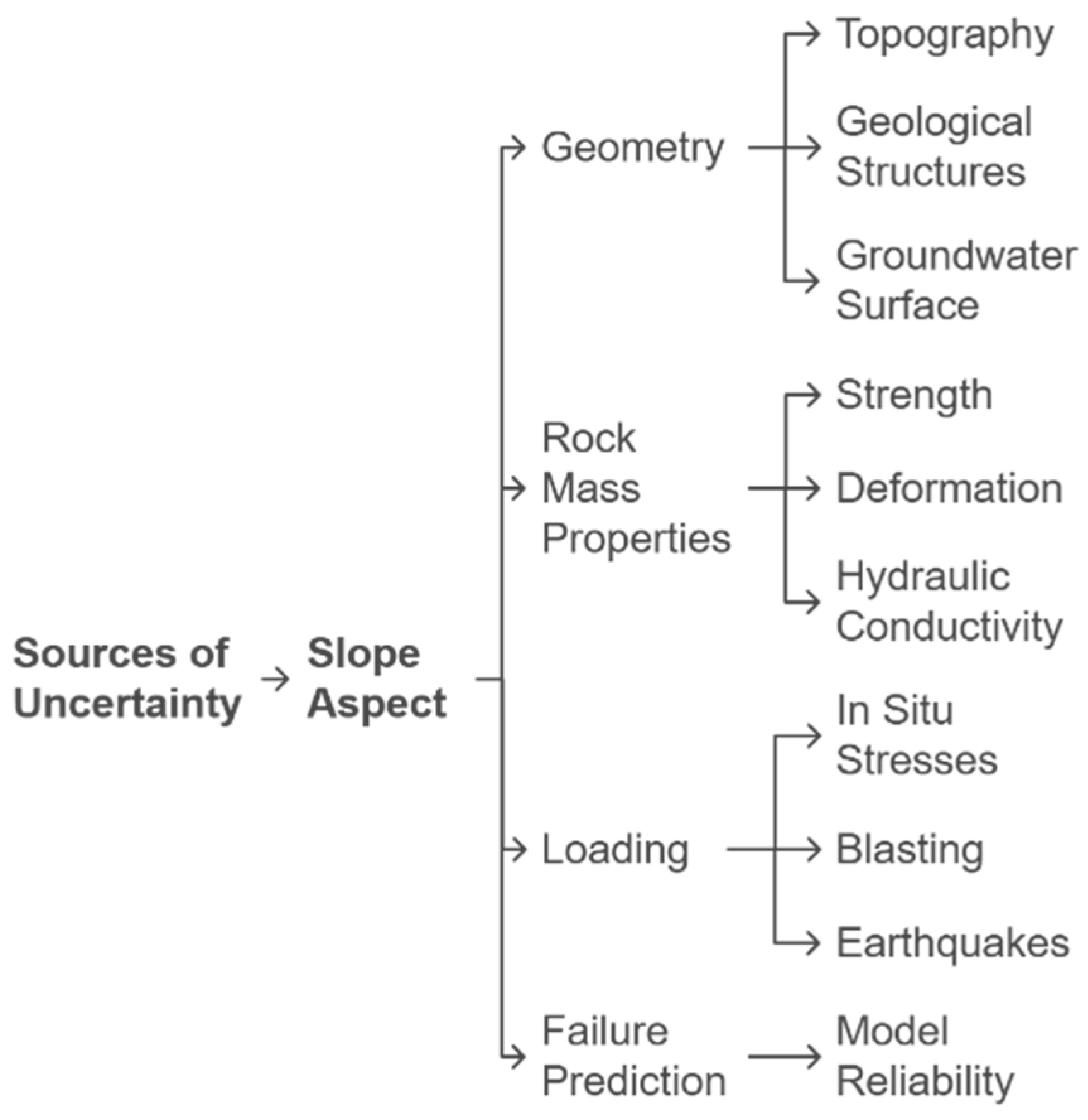
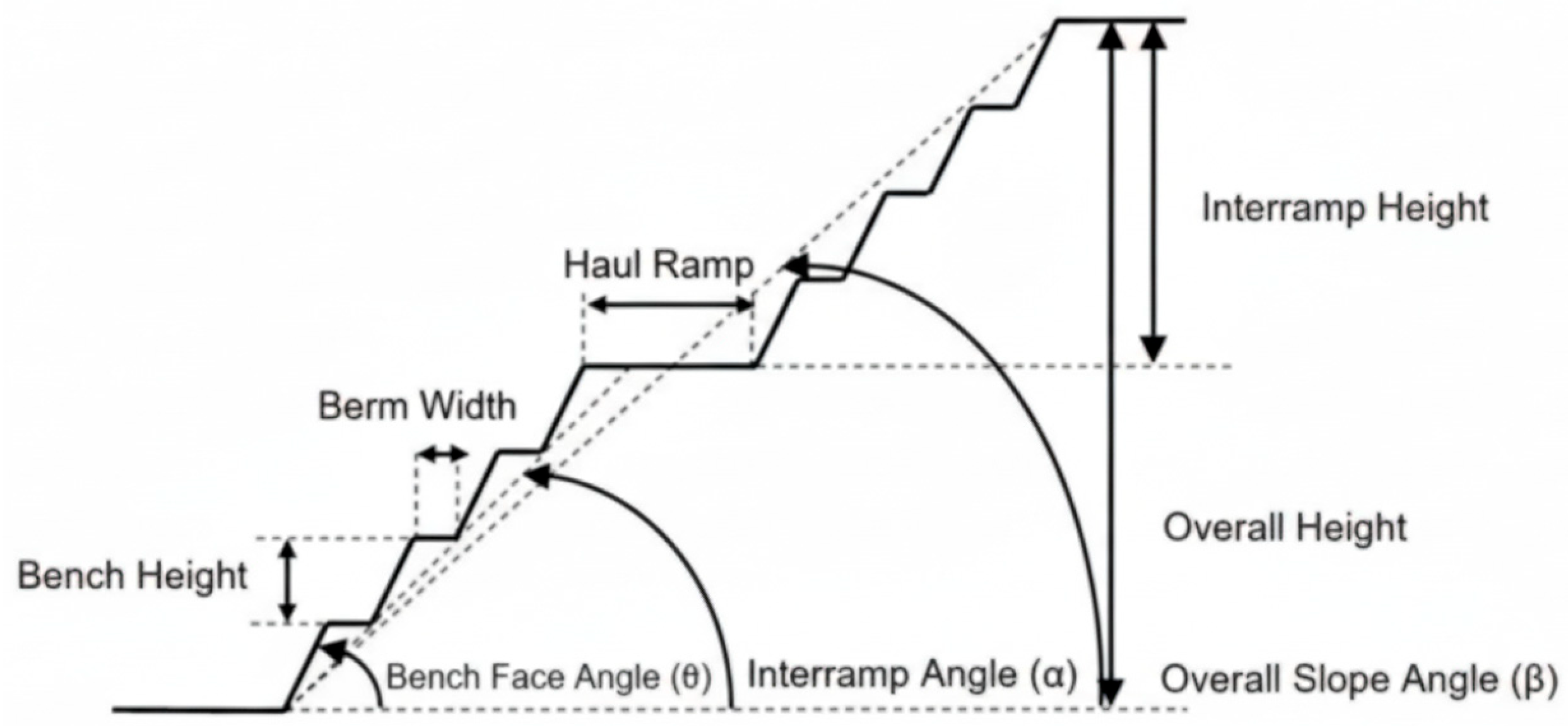
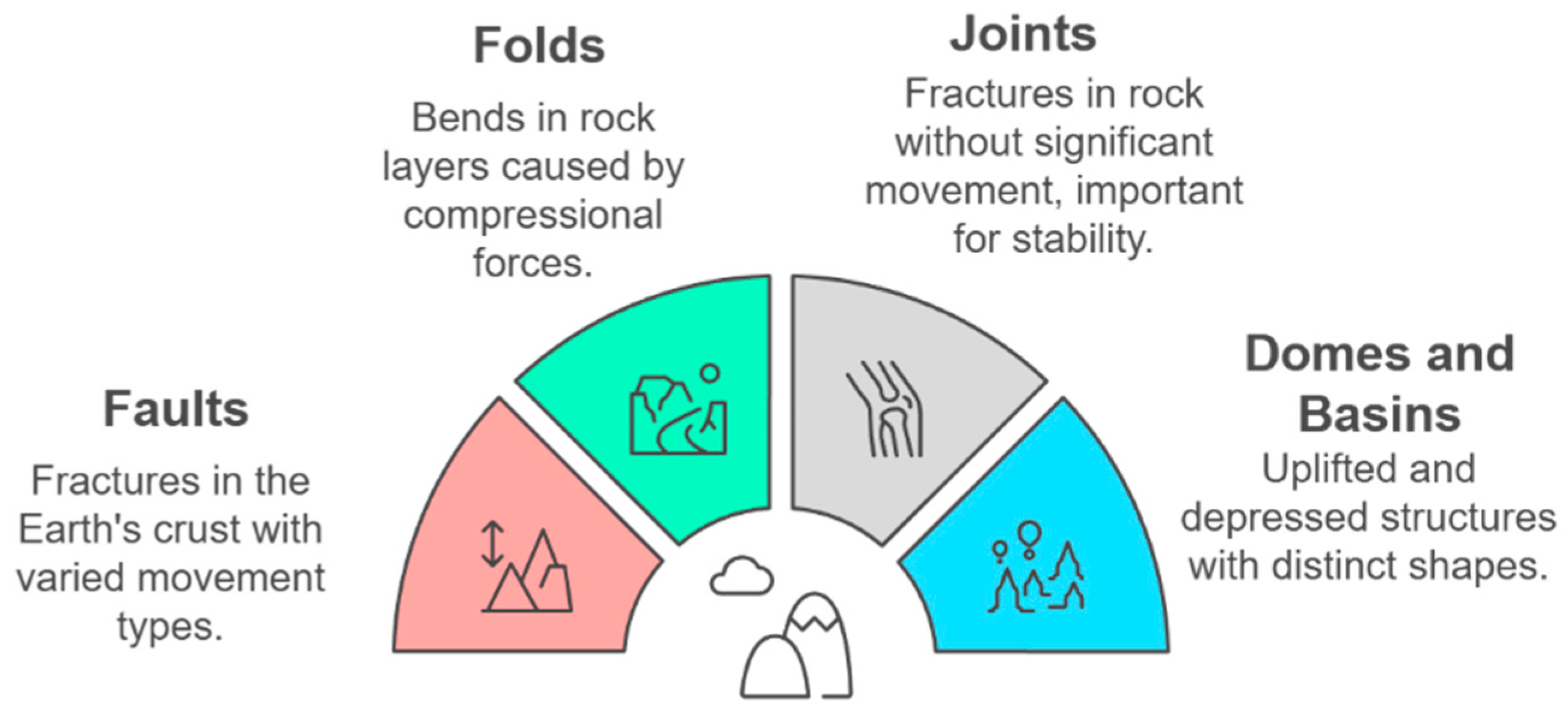
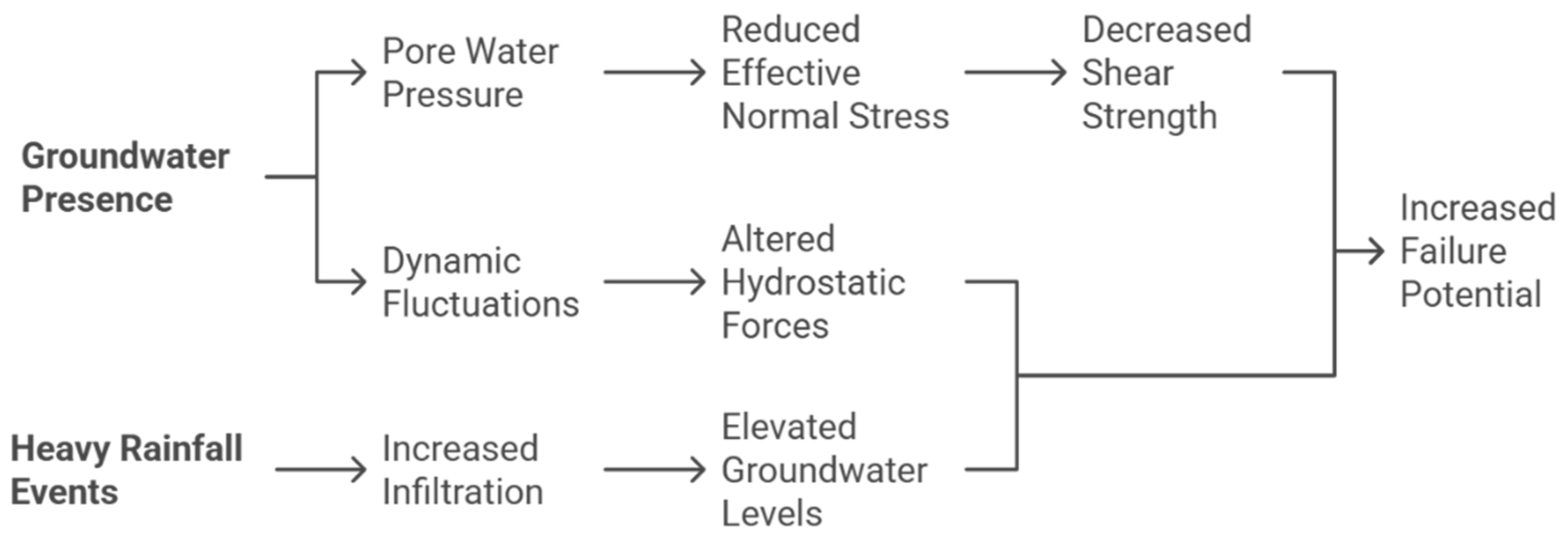


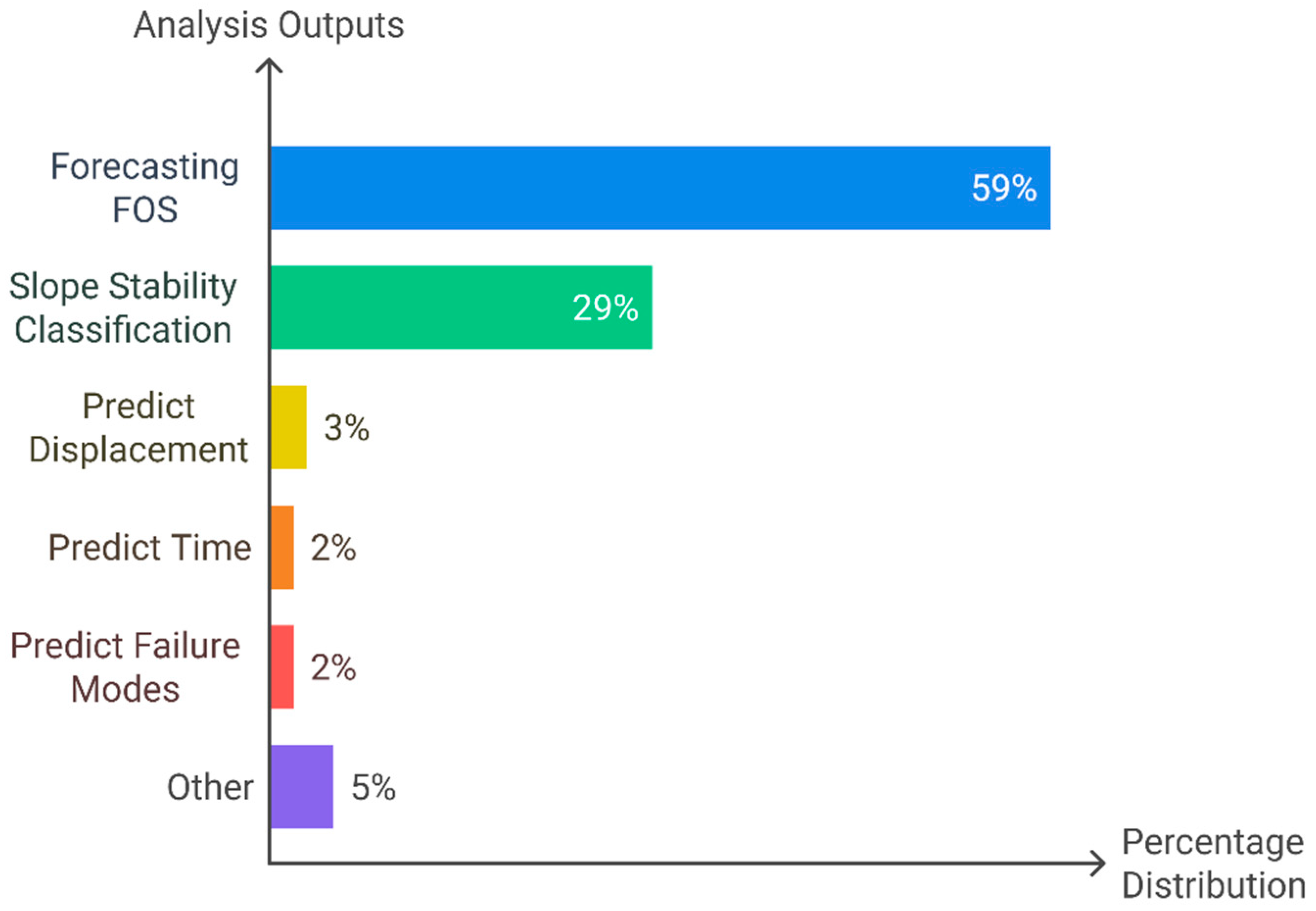
| Feature | MLP (Neural Network) | SVR (Support Vector Regression) | M5P (Model Tree Regression) |
|---|---|---|---|
| Accuracy | High accuracy, especially for complex and nonlinear relationships. | Performs well but may be sensitive to hyperparameter selection. | Generally, accuracy is high, though slightly lower than MLP in complex scenarios. |
| Computational Efficiency | Computationally expensive, especially for large datasets, requires high-performance computing resources (e.g., GPUs). | It is computationally efficient for small to medium datasets but can be slow for large-scale applications. | Highly efficient; pruning techniques reduce complexity, making it the fastest model among the three. |
| Interpretability | Considered a “black box” model, difficult to interpret due to the complexity of neural network layers. | It offers moderate interpretability, especially when using linear kernels. However, interpretability reduces with more complex kernels (e.g., RBF). | Highly interpretable, as the model follows a structured decision tree format, with linear regression applied at leaf nodes. |
| Handles Nonlinearity | Excellent at capturing nonlinear relationships due to deep network architecture. | Handles nonlinearity effectively through kernel functions (e.g., RBF, polynomial), but performance depends on kernel selection. | Limited ability to capture nonlinearity; performs best in datasets with mostly linear relationships. |
| Handles Small Datasets | Requires a large dataset for practical training; prone to overfitting in small datasets. | Well-suited for small datasets; capable of robust predictions with limited data points. | Well-suited for small datasets; capable of robust predictions with limited data points. |
| Risk of Overfitting | High risk of overfitting if not properly regularized (e.g., using dropout, L2 regularization). | Lower overfitting risk due to margin-based optimization; generalizes well with appropriate kernel selection | Moderate risk of overfitting but pruning techniques help maintain model generalization. |
| Feature | Extreme Gradient Boosting (XGBoost) | Random Forest (RF) | Support Vector Machine (SVM)P (Model Tree Regression) |
|---|---|---|---|
| Accuracy | Demonstrates high classification accuracy, particularly in large datasets with complex relationships. Achieves strong performance due to boosting-based learning. | It provides high accuracy but is slightly lower than XGBoost when handling highly nonlinear relationships. | Offers high accuracy for small to medium datasets, but performance depends on kernel selection. |
| Computational Efficiency | Moderate computational cost: optimized through parallelization and tree pruning, but still requires significant resources for large datasets. | It is computationally expensive, especially with large datasets, due to multiple decision trees. Training is also slower than XGBoost. | High computational cost for large datasets; solving quadratic optimization problems increases training time significantly. |
| Overfitting Resistance | It incorporates regularization (L1 & L2) to prevent overfitting. It requires careful hyperparameter tuning to balance the bias-variance tradeoff. | Resistant to overfitting due to averaging multiple decision trees. However, it may still overfit with excessive trees. | Generally, less prone to overfitting, mainly when appropriate kernel functions are selected. |
| Interpretability | Considered a black-box model due to complex tree interactions, making it challenging to interpret feature contributions. | Provides moderate interpretability through feature importance rankings. | Low interpretability, especially for nonlinear kernels, makes it challenging to extract geotechnical insights. |
| Handling of Nonlinear Relationships | Effectively captures nonlinear interactions through boosting, superior to Random Forest in complex decision boundaries. | Moderate performance in nonlinear datasets; performs well but is less flexible than XGBoost for complex relationships. | It is best suited for highly nonlinear datasets due to kernel-based learning, particularly with RBF and polynomial kernels. |
| Performance on Small Datasets | Performs better on large datasets but may overfit small datasets without proper tuning. | It requires a moderate dataset size to perform well; it may not be the best choice for very small datasets. | It best suits small datasets, where SVM’s structural risk minimization ensures good generalization. |
| Scalability | Effectively captures nonlinear interactions through boosting, superior to Random Forest in complex decision boundaries. | Moderate performance in nonlinear datasets; performs well but is less flexible than XGBoost for complex relationships. | Moderate performance in nonlinear datasets; performs well but is less flexible than XGBoost for complex relationships. |
| Robustness to Missing Data | Handles missing values well by learning optimal splits; imputation is often unnecessary. | Handles missing data moderately well but requires imputation in some cases. | Sensitive to missing values; typically requires preprocessing and imputation before training. |
| Feature Importance Analysis | It offers some feature importance insights but lacks interpretability compared to RF. | The best model for feature importance analysis is one that quickly identifies key geotechnical parameters. | Difficult to interpret feature contributions, particularly with kernel-based SVM models. |
Disclaimer/Publisher’s Note: The statements, opinions and data contained in all publications are solely those of the individual author(s) and contributor(s) and not of MDPI and/or the editor(s). MDPI and/or the editor(s) disclaim responsibility for any injury to people or property resulting from any ideas, methods, instructions or products referred to in the content. |
© 2025 by the authors. Licensee MDPI, Basel, Switzerland. This article is an open access article distributed under the terms and conditions of the Creative Commons Attribution (CC BY) license (https://creativecommons.org/licenses/by/4.0/).
Share and Cite
Trinidad, M.; Momayez, M. Machine Learning in Slope Stability: A Review with Implications for Landslide Hazard Assessment. GeoHazards 2025, 6, 67. https://doi.org/10.3390/geohazards6040067
Trinidad M, Momayez M. Machine Learning in Slope Stability: A Review with Implications for Landslide Hazard Assessment. GeoHazards. 2025; 6(4):67. https://doi.org/10.3390/geohazards6040067
Chicago/Turabian StyleTrinidad, Miguel, and Moe Momayez. 2025. "Machine Learning in Slope Stability: A Review with Implications for Landslide Hazard Assessment" GeoHazards 6, no. 4: 67. https://doi.org/10.3390/geohazards6040067
APA StyleTrinidad, M., & Momayez, M. (2025). Machine Learning in Slope Stability: A Review with Implications for Landslide Hazard Assessment. GeoHazards, 6(4), 67. https://doi.org/10.3390/geohazards6040067






